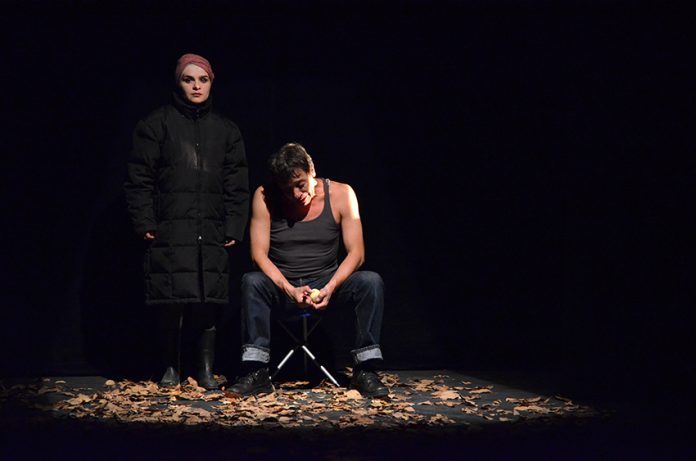Danáe Kótsiras, a Mexican woman of Greek extraction, lives in the peaceful country town of Etzatlán, Jalisco. Her principal activity is raising her 15-month-old daughter, but at that golden hour when the sun is about to set, you may see her walking the shadowy streets, photographing an ancient doorway or vine-covered ruins, with what is probably the only film camera in town.
I would not have guessed that Kótsiras is one of Guadalajara’s most talented photographers, a specialist in recording theatrical productions and concerts.

However, when a small book on local sculptor Pedro Díaz fell into my hands, I immediately appreciated the high quality of the photos within, especially because Don Pedrito loved to sculpt a soft volcanic rock called scoria – and I had found it extremely difficult to photograph what was essentially a sculpted cinder.
I wanted to meet the person who had taken those photos, and eventually, I had the chance. “How did you become a photographer of theater?” I asked Danáe Kótsiras.
Pushed to the stage
“When I was 18,” she told me, “I had to decide whether to study cinematography or theater. I opted for cinematography. Then I took a course in photojournalism with Luis Fernando Moreno Coronel, a famous photographer with the newspaper El Mural. He was bold and daring, and they called him “El Carajo” (“Mister No Shit”). Well, he pushed me and pushed me, and when he sent us to photograph stage shows, I felt right at home, because I loved the theater.”

At a certain point in their studies, Mexicans are expected to do social service: 480 hours of unpaid work during a period of six months to two years. When Kótsiras had nearly finished her studies, she was sent to do her social service as a photographer in the Dramatic Arts and Literature department of the University of Guadalajara (UdG).
“In 2011 I did my social service with them,” says Kótsiras, “and I ended up practically living in the Jalisco Experimental Theater in Guadalajara for about a year. Then, when I finished my service, the head of UdG Dramatic Arts, Lourdes González, hired me, and I worked there for almost three years.”
The technicians who make it all happen
Kótsiras enjoys shooting everything related to the theater: the shows, the rehearsals, the actors, the stage, the props, and especially the technicians. “People applaud the actors, but not the technicians who make it all happen, but in reality, they are the backbone of the theater,” she says.
During her many years of involvement with the theater, Kótsiras has developed a new understanding of the art.
“In Jalisco,” she says, “they are almost ashamed to charge people for a show, but creativity costs money and actors deserve a decent life because they create beauty, and who is going to pay us to create this beauty?”

The theater as a healer of souls
Kótsiras says she began to appreciate the importance of the theatre for humanity in general, when she went to Greece, the homeland of her grandfather, and visited the ruins of the Epidaurus Theater. This ancient theater is amongst the best-preserved in the ancient world and is famed for the harmony of its proportions and its exceptional acoustics.
“That theater,” says Kótsiras, “was actually a hospital, a sanitarium for those whose souls were sick. Asklepios appeared to the sick as a snake when he was going to cure them, and then the doctors hired musicians and actors to put on a play or a concert, so the infirm would laugh, would be moved, experience catharsis, and they would be cured and healed, because Hippocrates had said that all sickness is psychosomatic. Yes, The artist serves as a psychologist and as a psychiatrist, as a healer of souls. So art is a contribution to the mental health of the world. Some people say ‘Art is not a vital need,’ but I think it is every bit as important as food. It is just that we haven’t reflected on it.”
In 2020 Kótsiras got a grant to photograph all the women doing theater in Jalisco, and the results of her work—a study in black and white—are available for all to see on a web page called Mujeres de Teatro.
Photographing the forgotten
About this extraordinary collection, Circee Rangel, one of the most important figures in Guadalajara theater, says, “The theater is ephemeral and hard to document. Once the curtain closes, the protagonists are forgotten, especially if they worked behind the scenes or at a desk or in a control booth…and all the more so, if they were women.
“This collection of 250 photos honors all the women connected with the theater in Jalisco, not only the actors, directors, and producers, but also screenwriters, lighting techs, costumers, set designers, ushers, ticket sellers… everybody!
“These images, normally seen only by those who go behind the scenes or personally know us as weavers of theatrical art, are now laid before the curious eyes of anyone who opens this page in order to discover exactly who those women are, who create theater in Jalisco.”
Instagram: the new photo exhibit
Even though motherhood is presently her priority, last July found Kótsiras photographing shows at the Jalisco State Theater Festival. Some of those photos will be included in a retrospect of her works planned for the Palacio Municipal de Zapopan in 2024.
But you don’t have to wait until then.
“At the moment,” says Danáe Kótsiras, “the best place to view my photos is on Instagram, which, I would say, has become the modern equivalent of a photo exhibit.”
The writer has lived near Guadalajara, Jalisco, since 1985. His most recent book is Outdoors in Western Mexico, Volume Three. More of his writing can be found on his blog.
